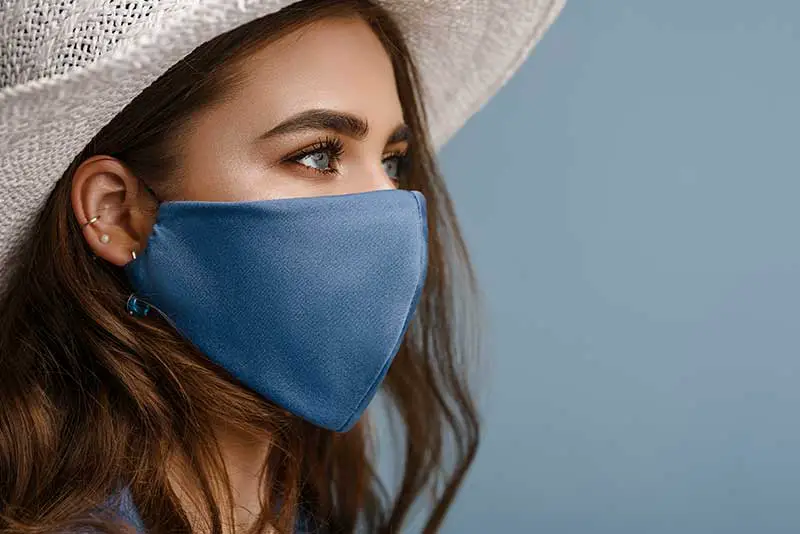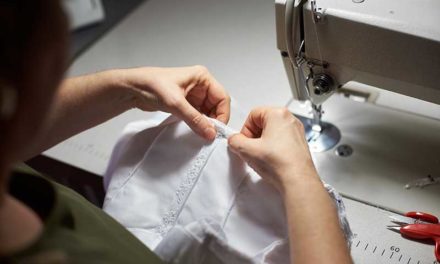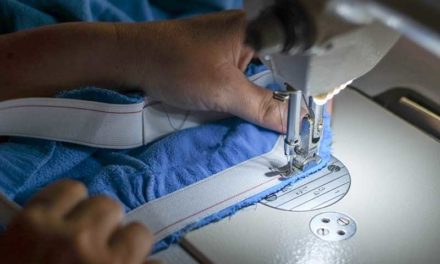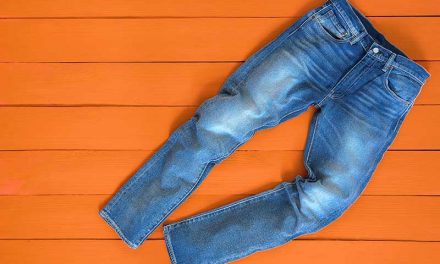One of the top stay-at-home activities during the pandemic is making DIY face masks. According to the CDC and WHO, wearing a face mask every time you go out in public can help protect you, your family, and everyone around you against Covid-19.
Learning how to sew a face mask requires a bit of sewing know-how. In fact, you only need to sew in a straight line to make a basic face mask. It’s an excellent pattern if you’re a newbie to sewing or you need a refresher. On top, it will only take you less than an hour to make it.
So if you’re looking for a fabric mask tutorial, you’re in the right place. This homemade cloth mask can serve as your protection when you’re grocery shopping, in the pharmacy, or in places where it’s hard to follow social distancing.
Table of Contents
- 1 How To Sew A Face Mask With Elastics
- 2 How To Sew A Face Mask With Ties
- 3 How To Make A No-Sew Face Mask
- 4 What’s The Best Material To Use For A Cloth Face Mask?
- 5 How To Properly Use Your Homemade Face Mask?
- 6 Is A Homemade Face Mask Truly Effective At Protecting Me From Viruses?
- 7 How To Care For Your Cloth Face Mask
- 8 Other Essential Things To Remember About Face Masks
How To Sew A Face Mask With Elastics
Materials You Need To Prepare
- A tight-weave cotton fabric like quilting cotton.
- Use a rope elastic or a beading cord elastic. A 1/8 inch flat elastic will also work if 1/4 inch is not available. If you can only find a wider flat elastic, you may cut it in half.
Things to keep in mind:
- Only use a new fabric that you have purchases within roughly the past year.
- Never use a used fabric.
- Before sewing, wash and dry your fabric without dyes or fragrances.
- One adult face mask will need two 9×6-inch pieces of tight-weave cotton and two 7-inch pieces of 1/4-inch elastic. Therefore, 1 yard of 44-inch wide fabric will produce around 12 to 15 masks.
- You need 7.5 yards of elastic for 25 masks (14 inches per mask).
Instructions
- Put the right sides of your cotton fabric together. If your fabric has a design, make sure to place the design horizontally.
- Cut 9×6 inches for an adult face mask or 7.5x 5 inches for a child face mask.
- Starting at the center of the bottom edge, sew to the first corner, stop.
- Sew the elastic with the edge out into the corner. A few stitches forward and back will hold this.
- Sew to the next corner, stop, and bring the other end of the same elastic to the corner and sew a few stitches forward and back.
- Now sew across that top of the mask to the next corner. Again, put an elastic with the edge out.
- Sew to the next corner and sew in the other end of the same elastic.
- Sew across the bottom leaving about 1.5” to 2” open. Stop, cut the thread.
- Turn inside out.
- Pin 3 tucks on each side of the mask. Make sure the tucks are in the same direction.
- Sew around the edge of the mask twice.
How To Sew A Face Mask With Ties
Materials You Need To Prepare
- A tight-weave cotton fabric.
- Bias tape. Either 1/2-inch or 7/8-inch will work. You can also make ties from strips of fabrics. Simply cut your fabric at 2-inch wide by 16-inch long.
Things to keep in mind:
- Make sure your fabric is new.
- Wash and dry your fabric without fragrance or dyes before sewing.
- An adult mask requires two 9x 6-inch pieces of tight-weave cotton and four 16-inch pieces of bias tape or fabric ties, that’s a total of 64 inches for each face mask. Hence, 1 yard of 44-inch wide fabric can make about 12 to 15 masks.
- You need 21 1/3 yards of bias tape for 12 masks.
Instructions
- Put the right sides of your cotton fabric together. If your fabric has a design, make sure to place the design horizontally.
- Cut 9×6 inches for an adult face mask or 7.5x 5 inches for a child face mask.
- Starting at the center of the bottom edge, sew around the edges of the fabric leaving about 1.5 to 2-inch open.
- Stop, cut the thread. Turn your fabric inside out.
- Pin three 1/2-inch tucks on each side of the mask. Make sure the tucks are in the same direction.
- Make ties using bias tape or fabric. Stitch closed for bias tape. On the other hand, for the fabric ties, fold it in half, turn under 1/4-inch on each long side, iron in place, and then stitch long edges closed.
- Pin one tie at each corner.
- Sew around the edge of the mask twice, catching the bias tape as you go.
How To Make A No-Sew Face Mask
Materials you’ll need:
- A bandana, scarf, handkerchief, or cotton fabric
- 2 Rubber bands or hair ties
- Filter (optional)
Instructions:
- Layout your fabric of choice or cut a 22x 22-inch square of cotton fabric.
- Place a flat filter in the center of the square. This is optional.
- Fold the top and bottom in towards the center.
- Fold the sides in towards the center. Loop the rubber bands or hair ties around the fabric.
- Tuck one end of the fabric into the other.
- Lift the mask to your face and secure the straps. Loop the rubber bands or hair ties over each ear.
- Adjust if necessary, ensuring your mouth and nose are covered entireley.
What’s The Best Material To Use For A Cloth Face Mask?
The best fabric you can use for your homemade face mask is a 100% cotton fabric that’s tightly woven. You can buy new fabric, but garments like curtains, bedsheets, and woven shirts are also good alternatives. If you’re going to donate the face masks you sew, it is advisable to avoid knit fabrics like jersey t-shirts. That’s because they produce holes when they stretch, which the viruses could get through.
Fabric Alternatives
Cotton fabric works best when learning how to sew a face mask. If you can’t find one, you may consider cutting up an old shirt or use an extra tea-towel. If you don’t have any cotton you can use, cut the pieces out of an old t-shirt.
Elastic Alternatives
If an elastic is not available, your other options include loops cut off of legging or thighs and rubber bands.
How To Properly Use Your Homemade Face Mask?
You can wear your DIY face mask when you’re out and about and around other people. These include getting necessities, visiting a healthcare provider, or going to the pharmacy.
But before going out, make sure to keep these things in mind:
- The ties or ear loops of your face mask are properly secured.
- Check that it has a snug yet comfortable fit.
- You can breathe without any difficulty.
- It should be at least made up of two layers of fabric.
When you’re wearing your mask, avoid touching it as much as possible. If you need to adjust it while you have it on, do not forget to sanitize or wash your hands right away afterward.
To remove your face mask, remember the following:
- Your hands should always be clean or sanitized.
- Remove your homemade cloth mask using its ties or loops. Do not touch its front part.
- During removal, avoid touching your eyes, nose, and mouth.
- After taking off your face mask, wash your hands thoroughly.
Is A Homemade Face Mask Truly Effective At Protecting Me From Viruses?
Aside from protecting yourself, one of the benefits of wearing the face mask you sew at home is that it can help protect others around you. Note that individuals who are presymptomatic or presymptomatic will still be able to transmit the virus to others when they sneeze, cough, or even talk.
When you wear a face mask, you are helping to contain likely infectious respiratory droplets. That way, you can prevent unknowingly transmitting the virus to others.
But can a cloth face mask also aid in preventing you from contracting the virus?
According to a study comparing homemade face masks, surgical masks, and N95 respirators, the latter provides the best protection from aerosols. Meanwhile, homemade face masks provide the least. Still wearing it is better than not wearing a mask at all.
In a 2013 study, 21 individuals were made to wear homemade face masks made from a t-shirt. Then, these cloth face masks were compared to N88 surgical face masks for their ability to block out viral and bacterial aerosols.
The study shows that both types of face masks can significantly reduce the transmission of these with surgical masks being more efficient. And although homemade masks are less efficient, they are more beneficial than not wearing anything at all.
How To Care For Your Cloth Face Mask
It’s essential to clean your DIY cloth face mask after every use. You can do this by applying a gentle cycle to your washing machine. Alternatively, you can carefully wash it by hand using warm, soapy water.
If you will insert a filter inside, remove and dispose of it properly before washing your mask.
When you’re done washing, dry your face mask in your dryer on high heat. If you don’t have a dryer, you can just hang your mask up to air dry. Once it is completely dry, it’s ready to use again. When using a filter together with your mask, dispose of the filter every time it gets wet from your reparations then wash your mask.
Other Essential Things To Remember About Face Masks
Although it is desirable to wear cloth face masks when going out in public places, it is not advisable for the following individuals to wear one:
- Children 2 years old and below.
- Those who are suffering from breathing problems.
- Incapacitated or unconscious individuals.
- If a person is unable to remove the covering without assistance.
To keep yourself safe from getting Covid-19, you will still need to follow social distancing guidelines. Moreover, you must wash your hands frequently and clean high-touch surfaces regularly.





